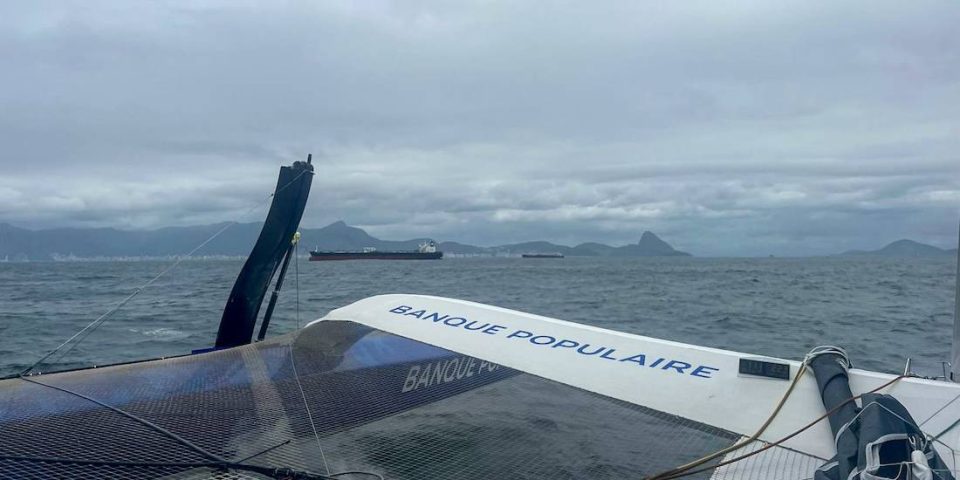The sixth week of the Arkea Ultim Challenge-Brest has once again not spared the five solo sailors still racing, with a technical stopover in New Zealand for Actual Ultim 3, and the announcement on Thursday morning of another stopover in Brazil for Armel Le Cléac’h. To break down the latest events in this marathon, Tip & Shaft interviewed former Vendée Globe race director Jacques Caraës, multihull specialist and race director Frédéric Le Peutrec, and Christophe Boutet, manager of Eric Péron’s Adagio team.
It’s a syndrome well known to round-the-world racers: the ‘true-false deliverance’ of the Horn. “After Le Maire Strait, you often have the impression that the job is done, that they’re safe, that home is no longer far away… but you always underestimate the final stretch,” stresses the experienced Jacques Caraës. Because once you’ve rounded that point, “there are still 7,000 miles ahead of you, more than any transatlantic race, with brutal temperature changes that are super traumatic for the body”, recalls Frédéric Le Peutrec, who sees this sixth week of racing as “the week of the worst”.
In fact, the three frontrunners in the fleet have shown signs of this “psychological yo-yo with some very violent aftershocks”, according to Christophe Boutet. Starting with Charles Caudrelier, who despite his large lead at the head of the fleet and his crossing of the equator on Friday, “appeared to be physically very scarred“, even injured in the collision with a wind turbine blade. “Psychologically, it’s a very difficult time. He’s attracted by this desire for victory that’s stretching out his arms, but the physical fatigue is scratching him a little more every day, and above all, nervously, he has to live in constant fear of the shock, and that everything he’s built will collapse in a second”, Jacques Caraës guesses.
Living “on a permanent ejector seat”
This situation is all the more exacerbated as “since the Horn, all the weather windows have closed in front of him”, notes Christophe Boutet, forcing the Maxi Edmond de Rotschild into some laborious manoeuvres. “In the South, it’s hard, but you go along with the weather systems and the pattern is fairly simple. On the way up, you have to get through them, with some extremely demanding changes of pace, difficult chop and terrible transitions”, lists Frédéric Le Peutrec, who reminds us that everyone “lives on a permanent ejection seat”.
Armel Le Cléac’h won’t be saying otherwise. He had held on to second place throughout the week despite having to deal with more than 50 knots of wind after rounding Cape Horn, but announced on Thursday morning that he would be diverting to Brazil after suffering major damage to his central rudder. “The question is to know how much the structure has suffered and whether he’ll be able to repair it and set off again”, lamented Jacques Caraës. “Psychologically, it’s really hard because he could have started to imagine attacking again at the end of the course.”
But after more than 40 days at sea, “the boats are bound to be put through their paces and it’s not surprising to have a few stops“, emphasises Frédéric Le Peutrec. Despite a number of slowdowns and a deficit on Banque Populaire XI which has increased from 300 miles at the Horn to nearly 800 miles in five days, Sodebo Ultim 3 is still struggling to make headway. “There has obviously been some damage. For the moment, Thomas seems to be managing. The challenge for him is not to stop again. But will his repairs be enough? After all, it’s the North Atlantic in the middle of winter. We have to make a clear assessment of the boat’s potential,” added the race management’s safety officer. Jacques Caraës regrets this very secretive side where nothing is revealed. They’re all so used to putting up with suffering that we don’t realise what they’re going through, which is a bit of a shame”.
For Adagio, “white bread
in the middle of a black runway”
In the midst of all this uncertainty and “the terrible weight of time”, according to Jacques Caraës, the light came from the man who, paradoxically, is the furthest from seeing the end of the tunnel. “It’s been the best week for Adagio since the start, admits Christophe Boutet. We attacked hard to hook onto a low-pressure system which we should be able to cross as far as the Horn. It came down to 5 hours.”
A fine reward for “all Eric’s self-sacrifice in this last-minute project”, emphasises Frédéric Le Peutrec, who sees it as “the moment of white bread in the middle of a black runway”. He owes this positive phase in particular to this “4×4 of the seas”, described by Jacques Caraës as “admittedly not as fast, but extremely robust and cut out for these conditions”. “The boat has all her potential, even if we’re sailing at 85% of the polar curve so as not to take too many risks,” confirms Christophe Boutet.
The situation is all the more positive for Eric Péron, as Anthony Marchand appears to be in a threefold decline up front. Firstly because of a stopover in New Zealand to remove Actual Ultim 3’s starboard foil, which logically caused him to lose ground. Secondly, because of the loss of a foil, which “slows him down, but also makes the boat less safe”, recalls Frédéric Le Peutrec. Finally, because the weather is forcing the skipper to slow down on the approach to Cape Horn, to avoid crossing in impassable conditions. “Adagio has a great carrot in front of her,” sums up Frédéric Le Peutrec.
Photo: Armel Le Cléac’h / Maxie Banque Populaire XI






